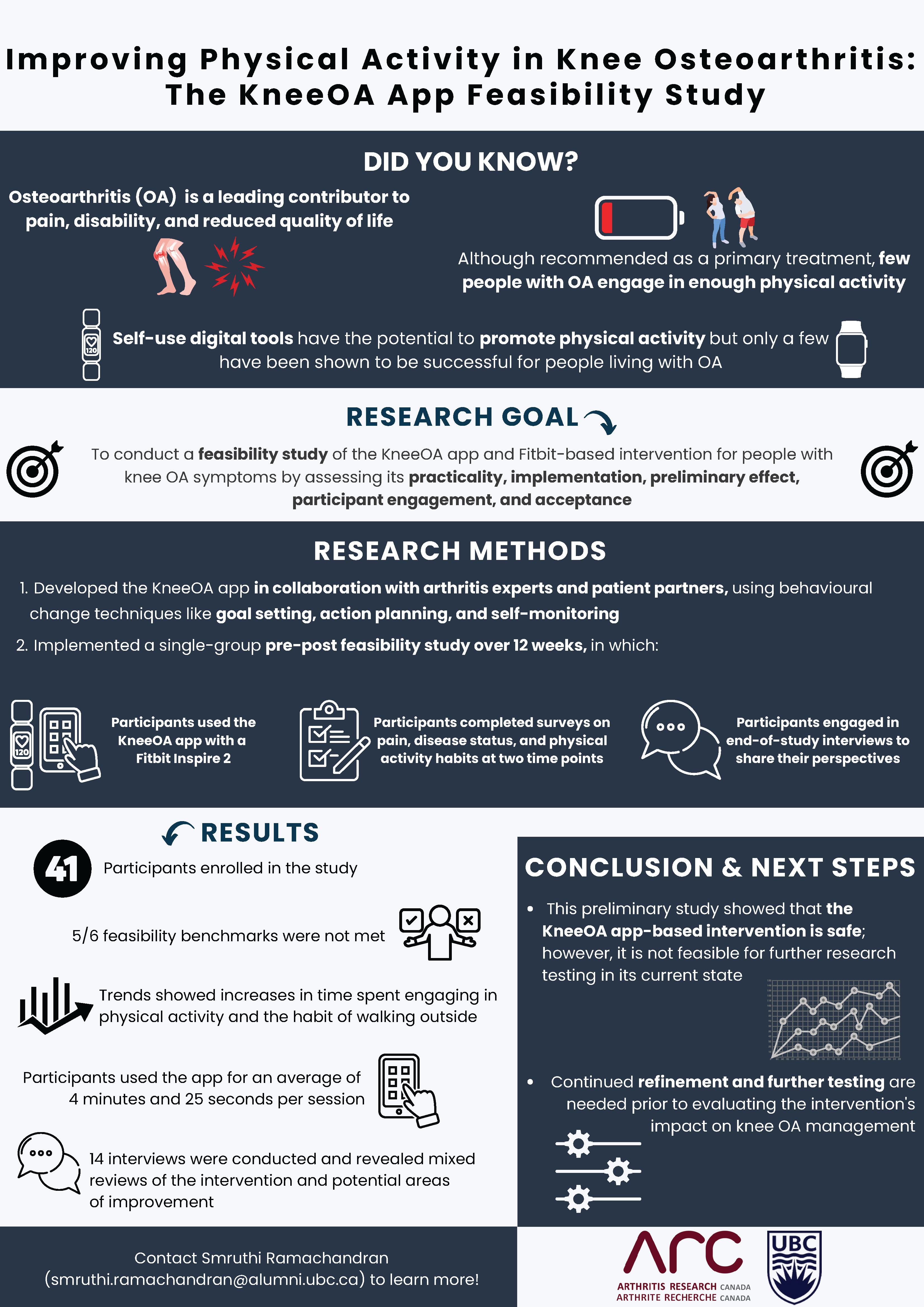Developing an App Which Will Empower Patients to Self-Diagnose and Manage Knee Osteoarthritis
Scientific Study Title:
Power to the Patients: Reshaping Knee Osteoarthritis Diagnosis and Secondary Prevention with E-Health
Start and End Date:
2018 – 2023
Why Did We Do This Research?
Early diagnosis and intervention are crucial for individuals with knee osteoarthritis (OA). Unfortunately, many of them do not receive proper advice and timely diagnosis, before damage to the joint occurs. This has been noted in studies in Ontario and British Columbia. At this point, treatment is exercise, weight management, and the use of the safest medication. To address this issue, we previously developed and tested a questionnaire and a mobile app, Arthritis ID, a mobile app that can diagnose knee OA with 95% certainty, even in very early disease (i.e., normal x-rays and only mild changes on MRI). Additionally, we created free online/mobile apps, called OPEN and FitViz for self-management of knee OA.
Currently, the three apps act independently as each serves a distinct function and a different user experience. However, they also share several overlapping functions, such as:
– Educational materials: Arthritis ID and OPEN
– Physical activity goal-setting functions: OPEN and Fitviz
In order to enhance convenience and adoption, we proposed combining these apps into a new super-app that empowers patients and provides optimal care.
What Did We Do?
We wanted to test whether the KneeOA app with the use of Fitbit devices could help people with knee pain become more active and self-manage their condition better. We also wanted to see how well participants could use the app and Fitbit as intended. Specifically, we conducted this research to:
1. See if people with knee pain could easily use the KneeOA app and Fitbit device together (practicality).
2. To understand how well the app and Fitbit could be used according to the outlined plan (implementation).
3. Understand if using the app and Fitbit could improve self-management and health outcomes such as physical activity, daily habits, pain levels, and overall health for people with knee pain (preliminary effect).
4. Learn how people with knee pain interacted with the KneeOA app and Fitbit—like how often they used it and what they did with it (engagement).
5. Find out if people with knee pain liked using the KneeOA app and Fitbit to help manage their condition and if they found it useful (acceptability).
We enrolled 41 participants who:
- Had an iPhone compatible with KneeOA (iPhone 6S or newer with iOS 13.1 or newer),
- Were over age 50,
- Had pain in one or both knees,
- Had knee pain, aching, or discomfort for 28 days in the past year
- Were physically inactive (score <14 on the Godin-Shephard Leisure-Time Physical Activity Questionnaire).
Participants used KneeOA with a Fitbit Inspire 2 for 12 weeks. They were encouraged to use the app at least once a week. Participants were asked to complete surveys about their pain, OA disease status, physical activity habits, and behaviours, before and after the intervention. Interviews were also conducted with 14 participants to gain insights into their experiences and perceptions of the KneeOA app and Fitbit-based intervention, focusing on acceptability.
What Did We Find?
Of the following 6 feasibility benchmarks, 1 was met.
1. Progress on action plan(s) reported on KneeOA ≥1 day per week.
2. Progress on goal(s) reported on KneeOA ≥1 day per week.
3. > 0 steps recorded on at least 3 of the 4 quarters in a day (6-hour intervals) on Fitbit for ≥ 80% of the days during the intervention period.
4. ≥ 70% of eligible individuals agree to participate.
5. ≤ 20% of participants who start the intervention drop out before completing the end-of-intervention assessment
6. ≥ 85% of participants who start the intervention adhere to the assessment protocol (complete both assessments before and after the intervention).
We also found:
– Positive indication of increases in number of days per week, minutes per week and overall habit of walking outside.
– Moderate engagement with the KneeOA app per session (average 4 mins/session)
– KneeOA app had lower engagement than some other health-related apps studied.
– Participants had mixed feelings of acceptability & clear benefits.
– Fitbit accuracy was questioned.
– Some participants found they were more accountable for their health outcomes.
In conclusion, the intervention showed promising trends in improving physical activity. There is room for improvement in the intervention’s feasibility, user engagement, Fitbit’s accuracy concerns, and perceived benefits of the app.

The Research Team
Principal Investigators:
Linda Li, PT, PhD; Senior Scientist, Arthritis Research Canada (University of British Columbia)
John Esdaile, MD, MPH, FRCPC, FCAHS; Scientific Director Emeritus, Arthritis Research Canada (University of British Columbia)
MSc Student and First Author:
Smruthi Ramachandran, MSc; Former Research Trainee, Arthritis Research Canada (University of British Columbia)
Co-investigators:
Chris Shaw MSc, PhD (Simon Fraser University)
Jolanda Cibere, MD, FRCPC, PhD; Senior Scientist, Rheumatology, Arthritis Research Canada (University of British Columbia)
Gillian Hawker (University of Toronto)
Hui Xie, BSc, MS, PhD; Research Scientist, Biostatistics, Arthritis Research Canada (Simon Fraser University)
Arthritis Patient Advisory Board Members:
Trish Silverster-Lee, Jon Collins, Isla Steele
The KneeOA mobile app was designed in collaboration with researchers from Arthritis Research Canada, patient leaders from Arthritis Consumer Experts, and app developers from Rolston Solutions Inc.
Who Funded This Research?
Canadian Initiative for Outcomes in Rheumatology Care (CIORA)
Related Publications
- Ramachandran, S. (2023). Feasibility of the KneeOA mobile application for managing knee osteoarthritis (T). University of British Columbia. Retrieved from https://open.library.ubc.ca/collections/ubctheses/24/items/1.0433749


















































